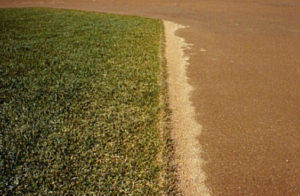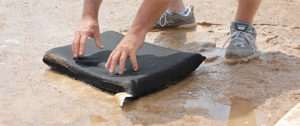March Madness is here! But, I’m not talking about basketball, even though I love that madness, as well. I’m thinking of the mad rush to get ballfields up and running for the season. Now that it’s March, coaches and players all over are preparing for their seasons. While ballfields in the south and west have come to life with the crack of the bat echoing through their parks, we in the north may still be recovering from a fairly deep snow cover & frost levels — not to mention the potential for flooding when it all melts. And coaches are getting itchy. Opening up your ballfield for the season in these climates must be done carefully in order to avoid damage to the playing surface. I have some tips to help you to get your fields ready as quickly as possible with the least amount of damage.
7 TIPS to get you back on your fields…
- If there is still some snow covering your field and the coaches are demanding that they absolutely need to get out there, you can work to remove the snow off the field. It will take equipment, manpower and time to get it done. Use plows on the grass that have either rubber scraper blades or use some type of pipe horizontally across the base of the plow to greatly reduce the potential for turf damage. If the snow is deep — 3-4 inches or more — be careful trying to push too much off at one time, you could begin to spin your wheels and that will severely damage the turf grass underneath.
- Once your field is snow free, wait until the field has lost all frost in the soil profile before attempting any work on the skin portion. If it’s too soft to walk on, you, nor anyone else should be on it. The field may look bone dry in the early morning because it is frozen, but as the sun heats the surface the infield skin can become a quagmire as the frost in the ground prevents the free water on the surface from draining through. You’ll know when the frost is out of the ground as the infield skin portion will drain fairly quickly and begin to dry off on the surface and firm up in the strong March sun and wind.
- If your field is in the northern part of the country where you get a depth of frost each year in the 3″ or more range, Mother Nature’s freeze-thaw cycle has naturally aerated your soils and opened up a tremendous amount of pore space in the soil profile. This natural aeration is fantastic for your turfgrass on the field but not for your infield skin surface. That pore space on a skin surface will fill with water on rainy days which will slow the skin from rapidly recovering after a rain event. By rolling the infield skin surface once it has dried enough to get equipment on it, you drastically reduce the pore space in the infield surface which seals the field back up so water will run off the field more efficiently.

- Fields without snow cover were at the mercy of the strong winds that come with the season. The strong winds can blow soil, drying agents and topdressing materials into the lips of the infield skin. These lips are natural dams impeding water from moving off your infield skin surface. Be sure to clean or edge out all lips to allow water to freely drain off the surface of the infield skin.

- Make sure the surface of the skin is smooth and level. Fall is actually the best time to re-level your infield skin so there are no low spots in the skin which will collect water. This exercise best prepares your field(s) for rapid water removal in the spring. If it wasn’t re-graded last fall, go out to the field right after a rain while there are still puddles on the infield skin and, using a rake, carve the outline of each puddle. When dry enough, nail drag the infield avoiding the low spots so you can find them, then use a Level Board to cut down the high spots and fill the low areas to help the water move off the infield more effectively.

- Keep some calcined clay drying agents around for those emergencies. But if the puddles are large or deep, then use a Beacon Puddle Sponge or a Big Gulp to remove excess water leaving just very shallow wet areas where drying agents can then work their magic.
- Whatever you do, NEVER use brooms to sweep excess water off an infield. You will only worsen the surface grade of the skin by sweeping more soil out thereby creating an even deeper hole for water to stand in. This will also build up the lips even worse creating a bigger dam along the edge.
If past winters have taught us anything, it is to always put your ballfields to sleep in the fall ready to play. You’ll find it makes your ensuing spring prep much easier. You can confidently get the coaching staff and their team out on their fields much more quickly. Spring weather should finally begin to shift northward next week across the eastern two-thirds of the country. Those of you in the south are probably relieved that you don’t deal with the cold, snow and frost. As a northerner, though, I’ll gladly take some snow and cold as an opportunity to catch a little break in the action as opposed to dealing with fire ants, mole crickets, excessive heat and a location where there are events on my field all year long… but then again, that’s just me! Good luck to everyone in preparing your fields.




